JAPANESE / ENGLISH

JAPANESE / ENGLISH
Last updated on 04/24/2021
The 100GBASE-LR4 standard is defined by IEEE as an Ethernet interface for transmitting 100 Gigabit Ethernet (100GbE) frames over 10 km of conventional SMF, and it has been one of the fastest-growing Ethernet interfaces in the 2010s. 100GBASE-LR4 uses four wavelengths in the O-band (1260-1360 nm), referred to as either DWDM or LAN-WDM wavelengths, and each of the four wavelength lanes carries 25 Gbps signal to support 100 Gbps (25 Gbps x 4) data rate.
Table 1: IEEE 100GBASE-LR4 optical interface summary
| Min | Max | ||
| Transmitter wavelength (nm) | Lane 0 | 1294.53 | 1296.59 |
| Lane 1 | 1299.02 | 1301.09 | |
| Lane 2 | 1303.54 | 1305.63 | |
| Lane 3 | 1308.09 | 1310.19 | |
| Average launch power per lane (dBm) | -3.8 | 4.0 | |
| Average receive power per lane (dBm) | -10.1 | 4.0 | |
| Channel insertion loss (dB) | 6.3 | — | |
| Operating distance (km) | — | 10 | |
Praseodymium-Doped Fiber Amplifier (PDFA) is known to have its gain in the O-band, and the gain peak matches the 100GBASE-LR4 wavelengths. FiberLabs is the only manufacturer of O-band PDFA, and our PDFA features:
Typical amplification characteristics of AMP-FL56xx-OB-16 are shown below. Specifications of all PDFA products can be found via the following links.
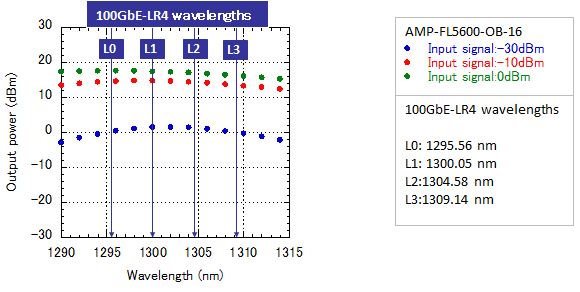
PDFA’s superior optical characteristics are unrivaled by alternative schemes (e.g. Semiconductor Optical Amplifier (SOA) and Raman amplifier), providing a solid and versatile platform for amplifying 100GBASE-LR4 signal. Typical applications of FiberLabs’ PDFA for 100GBASE-LR4 are listed in the following.
We have done a couple of transmission experiments using a standard QSFP28 100GBASE-LR4 transceiver. By clicking the links above, you can get general ideas how PDFA works for each of the applications.
Figure 2 shows an example where PDFA is used for optical port mirroring. Two optical TAPs are inserted in the main network, and the splitting ratio is set to a low value (e.g. 90/10) in order to minimize the impact to the main traffic. Two PDFAs are placed in the mirrored port and compensate the loss induced by splitting. Indeed, PDFA enables a large output power without suffering signal distortion, and the output power out of the PDFAs can be larger than that of the main traffic. It is therefore possible to simultaneously provide sufficient input power to multiple network monitoring appliances (e.g. traffic monitoring, fault detection, and deep packet inspection…), or to deliver the duplicated packets to a remote site.
(Click here to see our technical article showing how PDFA can be used for this purpose)
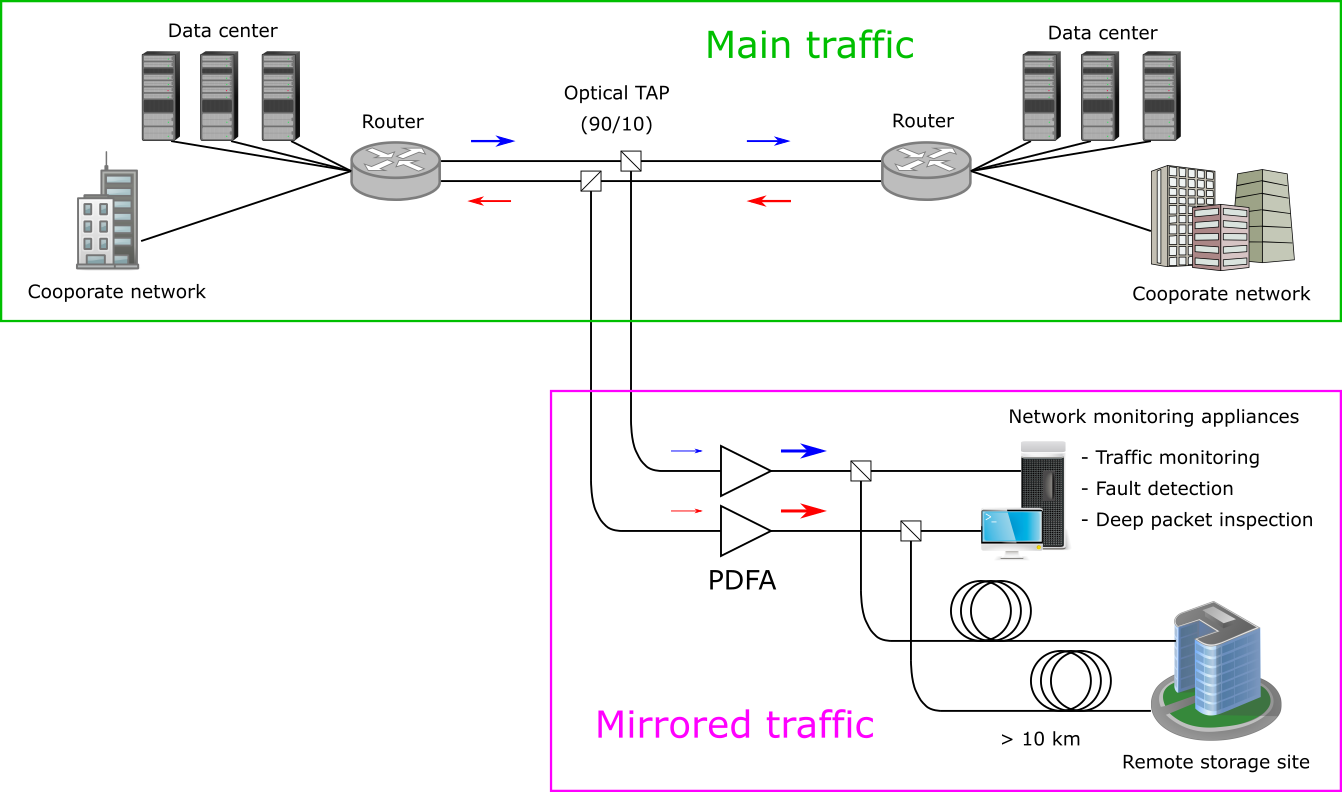
Figure 2: Application of PDFA for port mirroring in high-speed ethernet.
There are currently two commercially available options in amplifying 100GBASE-LR4 signal – PDFA and SOA. Both have pros and cons, and they are summarized in the following.
In general, PDFA surpasses SOA in optical performance. For example, FiberLabs’ PDFA offers higher maximum output power (+20dBm) and small signal gain (>25dB) than comparable SOA-based amplifiers. In addition, SOA cannot be used as a booster amplifier due to low output power and nonlinear optical effects.
On the other hand, SOA-based amplifier is generally smaller in size and is commonly used as a preamplifier in a 100GBASE-ER4 transceiver.
Table 2: O-band optical amplifier performance comparison summary
| FiberLabs’ PDFA | SOA | |
| Maximum output power | up to +20 dBm | < +10 dBm |
| Small signal gain | > 25 dB | ∼ 20 dB |
| Noise figure | < 7 dB | < 8 dB |
| Amplifier configuration | Booster/inline/pre-amplifer | pre-amplifier only |
| Footprint | Maximum 4 amplifiers in 19-inch chasis | Can be integratedinside transceiver module |
FiberLabs’ 19-inch 1U chasis can carry maximum four PDFAs, and a booster amplifier and pre-amplifier can coexist. This allows network operators to install PDFAs at only one side of the LR4 transceiver pair (see below), simplifying the installation and maintenance of reach extension.
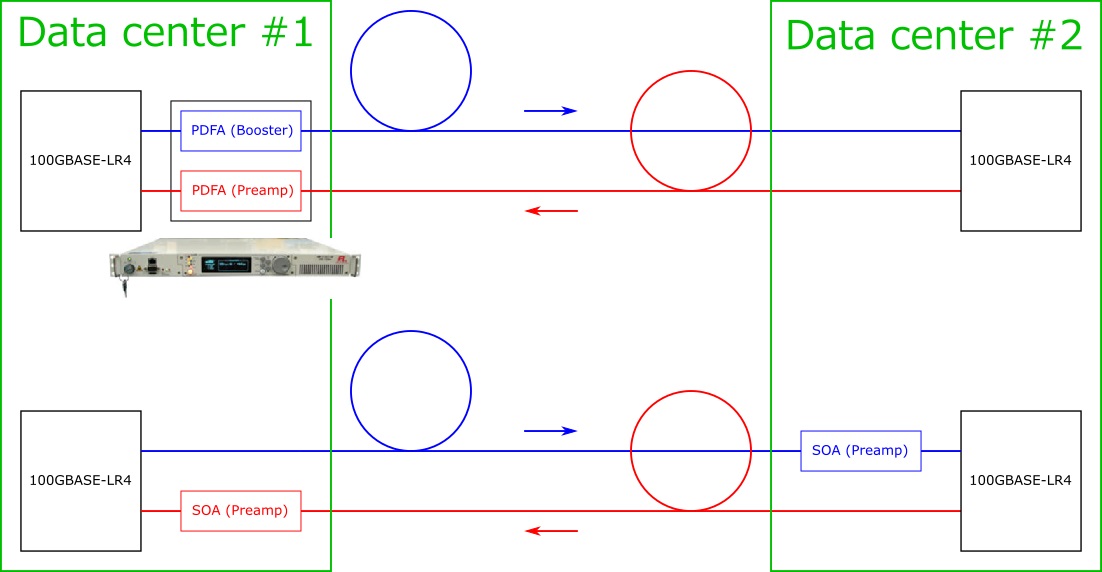
Schematic of one network configuration, where using PDFA has an advantage in extending the reach. PDFA is installed at only one side of the network, while SOA needs to be installed at both sides.
The following is an example, in which FiberLabs’ AMP-FL56xx-OB series PDFA is used as a reach extender for 100GBASE-LR4 transmission.
First, AMP-FL5600-OB-16 was used as the booster amplifier. The four signals from a 100GBASE-LR4 CFP were directly connected to the amplifier and were amplified by more than 10 dB per lane. Gain variation between the lanes was less than 1 dB. A link budget of 20dB was confirmed by using 55 km of SMF and an optical attenuator.
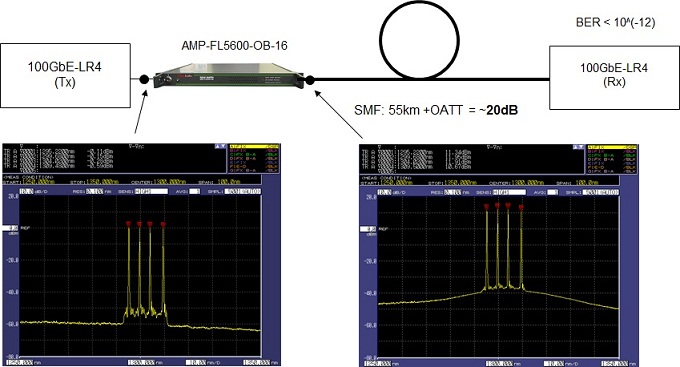
In the second scheme, a pre-amplifier configuration was used. The four wavelength signals were simultaneously amplified by AMP-FL5600-OB-13 to be within the range of receiver sensitivity after being attenuated by 23dB/lane using 55 km of SMF and an optical attenuator. A link budget of greater than 20 dB was confirmed.
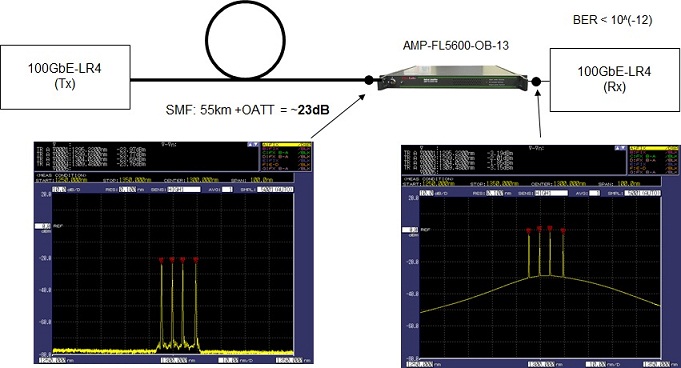
Finally, AMP-FL5600-OB amplifiers were used as both the booster amplifier and pre-amplifier. A link budget of greater than 30dB was confirmed using 60 km of SMF and an optical attenuator.
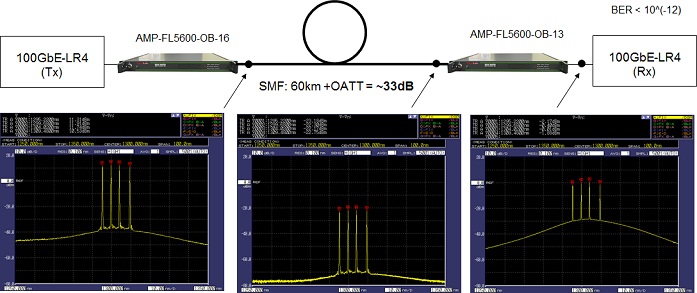
It should be noted that the reach is not limited to 60 km, but a larger link budget and further reach extension should be possible by using inline amplifiers in addition to the booster amplifier and pre-amplifier.
FiberLabs offers the following products related to this article. Please visit these pages if you are interested in this article.